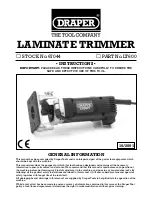
7
5. To reduce risk of damage to electric plug and cord, pull by plug rather than cord when
disconnecting charger.
6. Make sure cord is located so that it will not be stepped on, tripped over, or otherwise
subjected to damage or stress.
7. An extension cord should not be used unless absolutely necessary. Use of improper
extension cord could result in a risk of fire, electric shock or electrocution.
a. An extension cord must have adequate wire size (AWG or American Wire Gauge) for safety,
and to prevent loss of power and overheating. The smaller the gauge number of the wire, the
greater the capacity of the cable; that is, 16 gauge has more capacity than 18 gauge. When
using more than one extension to make up the total length, be sure each extension contains
at least the minimum wire size.
8. Use only the supplied charger when charging your tool. The use of any other charger could
damage the tool or create a hazardous condition.
9. Use only one charger when charging.
10. Do not attempt to open the charger.
11. DO NOT incinerate the tool or batteries even if they are severely damaged or completely
worn out. The batteries can explode in a fire. Toxic fumes and materials are created when
lithium ion battery packs are burned.
12. Do not charge or use battery in explosive atmospheres, such as in the presence of
flammable liquids, gases or dust. Inserting or removing the battery from the charger may
ignite the dust or fumes.
13. If battery contents come into contact with the skin, immediately wash area with mild soap
and water. If battery liquid gets into the eye, rinse water over the open eye for three minutes
or until irritation ceases. If medical attention is needed, the battery electrolyte is composed of
a mixture of liquid organic carbonates and lithium salts.
Burn hazard. Battery liquid may be flammable if exposed to spark or flame.
CHARGER OPERATION
Charge only iON+ 20V lithium-ion battery packs with their compatible iON+ 20V lithium-ion
charger. Other types of batteries may cause personal injury and damage.To reduce the risk of
electric shock, do not allow water to flow into the charger's AC/DC plug.
When to Charge the iON+ 20V Lithium-Ion Batteries
NOTE: The iON+ 20V lithium-ion
battery packs do not develop a "memory" when charged after only a partial discharge.
Therefore, it is not necessary to run down the battery packs before placing them into the
charger.
• Use the battery charge indicator lights to determine when to charge your iON+ 20V lithium-ion
battery packs.
• You can "top-off" your battery packs' charge before starting a big job or after a long day of
use.
Charging Procedure
IMPORTANT
: The battery pack is not fully charged at the factory. Before attempting to charge
them, thoroughly read all of the safety instructions.
(1) To assure that the charger you use are applicable to the battery pack.
(2) Plug the charger plug into the charging hole of the battery pack.
(3) Plug the charger into any suitable standard outlet.
(4) Let the battery pack charge initially for the green light is twinkled. If the power lights are all
lighting, the battery pack is fully charged.
Содержание GUT099
Страница 19: ......
Страница 20: ...Great Circle USA Support Line 1 866 493 0524 help greatcircleus com www greatcircleus com...






































